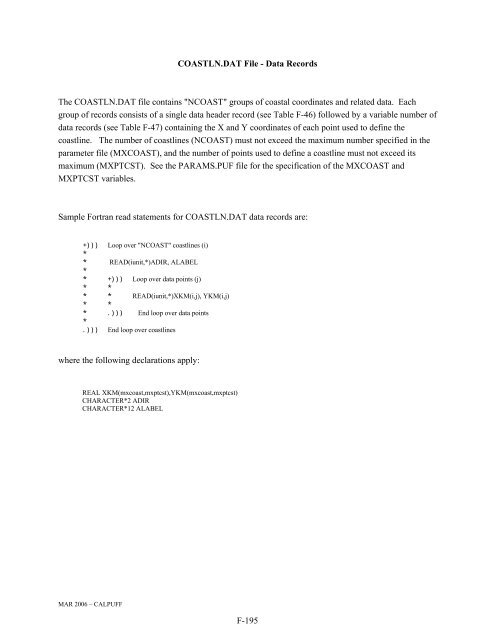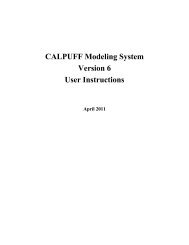- Page 1:
Development of the Next Generation
- Page 4 and 5:
F. CALPUFF MODEL FILES The CALPUFF
- Page 6 and 7:
are all equivalent). The variable t
- Page 8 and 9:
Table F-1 Input Groups in the CALPU
- Page 10 and 11:
Table F-2 Sample CALPUFF Control Fi
- Page 12 and 13:
Table F-2 (Continued) Sample CALPUF
- Page 14 and 15:
Table F-2 (Continued) Sample CALPUF
- Page 16 and 17:
Table F-2 (Continued) Sample CALPUF
- Page 18 and 19:
Table F-2 (Continued) Sample CALPUF
- Page 20 and 21:
Table F-2 (Continued) Sample CALPUF
- Page 22 and 23:
Table F-2 (Continued) Sample CALPUF
- Page 24 and 25:
Table F-2 (Continued) Sample CALPUF
- Page 26 and 27:
Table F-2 (Continued) Sample CALPUF
- Page 28 and 29:
Table F-2 (Continued) Sample CALPUF
- Page 30 and 31:
Table F-2 (Continued) Sample CALPUF
- Page 32 and 33:
Table F-2 (Continued) Sample CALPUF
- Page 34 and 35:
Table F-2 (Continued) Sample CALPUF
- Page 36 and 37:
Table F-2 (Continued) Sample CALPUF
- Page 38 and 39:
Table F-2 (Continued) Sample CALPUF
- Page 40 and 41:
Table F-2 (Continued) Sample CALPUF
- Page 42 and 43:
Table F-3 CALPUFF Control File Inpu
- Page 44 and 45:
Table F-3 (Continued) CALPUFF Contr
- Page 46 and 47:
Table F-3 (Continued) CALPUFF Contr
- Page 48 and 49:
Table F-3 (Continued) CALPUFF Contr
- Page 50 and 51:
Table F-3 (Continued) CALPUFF Contr
- Page 52 and 53:
Table F-3 (Continued) Control File
- Page 54 and 55:
Table F-3 (Continued) Control File
- Page 56 and 57:
Table F-3 (Continued) CALPUFF Contr
- Page 58 and 59:
Table F-3 (Continued) CALPUFF Contr
- Page 60 and 61:
Table F-3 (Continued) CALPUFF Contr
- Page 62 and 63:
Table F-3 (Continued) CALPUFF Contr
- Page 64 and 65:
Table F-3 (Continued) CALPUFF Contr
- Page 66 and 67:
Table F-3 (Continued) CALPUFF Contr
- Page 68 and 69:
Table F-3 (Continued) CALPUFF Contr
- Page 70 and 71:
Table F-3 (Continued) CALPUFF Contr
- Page 72 and 73:
Table F-3 (Continued) CALPUFF Contr
- Page 74 and 75:
Table F-3 (Continued) CALPUFF Contr
- Page 76 and 77:
Table F-3 (Continued) CALPUFF Contr
- Page 78 and 79:
Table F-3 (Continued) CALPUFF Contr
- Page 80 and 81:
Table F-3 (Continued) CALPUFF Contr
- Page 82 and 83:
Table F-3 (Continued) CALPUFF Contr
- Page 84 and 85:
Table F-3 (Continued) CALPUFF Contr
- Page 86 and 87:
Table F-3 (Continued) CALPUFF Contr
- Page 88 and 89:
Table F-3 (Continued) CALPUFF Contr
- Page 90 and 91:
Table F-3 (Continued) CALPUFF Contr
- Page 92 and 93:
Table F-3 (Concluded) CALPUFF Contr
- Page 94 and 95:
c --- c --- c --- c --- c --- c ---
- Page 96 and 97:
write(iunit)CLABTK,NDATHR,TEMPK wri
- Page 98 and 99:
Table F-4 (Continued) CALMET.DAT fi
- Page 100 and 101:
Table F-4 (Concluded) CALMET.DAT fi
- Page 102 and 103:
Table F-5 (Continued) CALMET.DAT fi
- Page 104 and 105:
F.2.2 ISCMET.DAT CALPUFF can be dri
- Page 106 and 107:
Table F-6 Sample ISCMET.DAT files (
- Page 108 and 109:
Table F-8 ISCMET.DAT File - Data Re
- Page 110 and 111:
table. A description of the content
- Page 112 and 113:
Table F-10 PLMMET.DAT File - Header
- Page 114 and 115:
F.2.4 SURFACE.DAT and PROFILE.DAT I
- Page 116 and 117:
Table F-12 Sample SURFACE.DAT file
- Page 118 and 119:
Table F-14 SURFACE.DAT File - Data
- Page 120 and 121:
F.3 Point Source Emissions File Wit
- Page 122 and 123:
PTEMARB.DAT File - Header Records T
- Page 124 and 125:
Table F-17 (Continued) PTEMARB.DAT
- Page 126 and 127:
Table F-17 (Concluded) PTEMARB.DAT
- Page 128 and 129:
Table F-18 PTEMARB.DAT - Time-Invar
- Page 130 and 131:
Table F-19 (Concluded) PTEMARB.DAT
- Page 132 and 133:
Table F-20 Sample BAEMARB.DAT file
- Page 134 and 135:
Table F-21 BAEMARB.DAT - Header Rec
- Page 136 and 137:
Table F-21 (Continued) BAEMARB.DAT
- Page 138 and 139:
BAEMARB.DAT File - Data Records The
- Page 140 and 141:
Table F-23 BAEMARB.DAT - Time-Varyi
- Page 142 and 143:
F.5 Line Source Emissions File With
- Page 144 and 145:
LNEMARB.DAT File - Header Records T
- Page 146 and 147:
Table F-25 (Continued) LNEMARB.DAT
- Page 148 and 149: Table F-25 (Concluded) LNEMARB.DAT
- Page 150 and 151: Table F-26 LNEMARB.DAT - Time-Invar
- Page 152 and 153: Table F-27 (Continued) LNEMARB.DAT
- Page 154 and 155: Table F-27 (Concluded) LNEMARB.DAT
- Page 156 and 157: Table F-28 Sample VOLEMARB.DAT file
- Page 158 and 159: Table F-29 VOLEMARB.DAT - Header Re
- Page 160 and 161: Table F-29 (Continued) VOLEMARB.DAT
- Page 162 and 163: VOLEMARB.DAT File - Data Records Th
- Page 164 and 165: Table F-30 VOLEMARB.DAT - Time-Inva
- Page 166 and 167: Table F-31 (Concluded) VOLEMARB.DAT
- Page 168 and 169: values in time provided in Input Gr
- Page 170 and 171: Table F-32 (Continued) Boundary Con
- Page 172 and 173: Table F-32 (Continued) Boundary Con
- Page 174 and 175: Table F-33 BCON.DAT File Inputs Var
- Page 176 and 177: Table F-33 (Concluded) BCON.DAT Fil
- Page 178 and 179: Table F-34 Sample User-Specified De
- Page 180 and 181: Table F-35 Sample Hourly Ozone Data
- Page 182 and 183: Table F-36 OZONE.DAT - Header Recor
- Page 184 and 185: Table F-37 OZONE.DAT - Time-Invaria
- Page 186 and 187: F.10 User-Specified Chemical Transf
- Page 188 and 189: F.11 Site-Specific Turbulence Data
- Page 190 and 191: Table F-40 Sample CTDMPLUS Terrain
- Page 192 and 193: Table F-42 HILL.DAT File - Record G
- Page 194 and 195: F.13 Subgrid Scale Coastal Boundary
- Page 196 and 197: COASTLN.DAT File - Header Record Th
- Page 200 and 201: Table F-47 COASTLN.DAT - Data Recor
- Page 202 and 203: Table F-48 Sample Mass Flux Boundar
- Page 204 and 205: Table F-49 FLUXBDY.DAT - Header Rec
- Page 206 and 207: Table F-50 FLUXBDY.DAT - Data Heade
- Page 208 and 209: F.15 CALPUFF Output Files F.15.1 Li
- Page 210 and 211: where the following declarations ap
- Page 212 and 213: Table F-52 (Continued) Unformatted
- Page 214 and 215: Table F-52 (Continued) Unformatted
- Page 216 and 217: Table F-52 (Continued) Unformatted
- Page 218 and 219: Table F-52 (Continued) Unformatted
- Page 220 and 221: Table F-52 (Concluded) Unformatted
- Page 222 and 223: Table F-53 Unformatted CONC.DAT Fil
- Page 224 and 225: F.15.4 Dry Flux File (DFLX.DAT) The
- Page 226 and 227: Table F-54 Unformatted DFLX.DAT fil
- Page 228 and 229: Table F-54 (Continued) Unformatted
- Page 230 and 231: Table F-54 (Continued) Unformatted
- Page 232 and 233: Table F-54 (Continued) Unformatted
- Page 234 and 235: Table F-54 (Continued) Unformatted
- Page 236 and 237: DFLX.DAT File - Data Records The DF
- Page 238 and 239: Table F-55 (Concluded) Unformatted
- Page 240 and 241: Character*132 COMMENT Character*80
- Page 242 and 243: Table F-56 (Continued) Unformatted
- Page 244 and 245: Table F-56 (Continued) Unformatted
- Page 246 and 247: Table F-56 (Continued) Unformatted
- Page 248 and 249:
Table F-56 (Continued) Unformatted
- Page 250 and 251:
Table F-56 (Concluded) Unformatted
- Page 252 and 253:
Table F-57 Unformatted WFLX.DAT Fil
- Page 254 and 255:
F.15.6 Relative Humidity File for V
- Page 256 and 257:
Table F-58 Unformatted VISB.DAT fil
- Page 258 and 259:
Table F-58 (Continued) Unformatted
- Page 260 and 261:
Table F-58 (Continued) Unformatted
- Page 262 and 263:
Table F-58 (Continued) Unformatted
- Page 264 and 265:
Table F-58 (Continued) Unformatted
- Page 266 and 267:
VISB.DAT File - Data Records The VI
- Page 268 and 269:
Table F-59 (Concluded) Unformatted
- Page 270 and 271:
Table F-60 Sample Debug Puff-Tracki
- Page 272 and 273:
F.15.8 Mass Flux List File (MASSFLX
- Page 274 and 275:
F.15.9 Mass Balance List File (MASS
- Page 276 and 277:
F.16 OPTHILL When the subgrid scale
- Page 278 and 279:
The following procedure is recommen
- Page 280 and 281:
Table F-64 OPTHILL Input and Output
- Page 282 and 283:
Figure F-2 Map of terrain surroundi
- Page 284 and 285:
Table F-67 OPTHILL Output File for
- Page 286 and 287:
This process is simplified somewhat
- Page 288 and 289:
G.1 PRTMET Meteorological Display P
- Page 290 and 291:
Table G-1 PRTMET Input and Output F
- Page 292 and 293:
Table G-2 (Continued) PRTMET Contro
- Page 294 and 295:
Table G-2 (Concluded) PRTMET Contro
- Page 296 and 297:
Table G-3 Sample PRTMET Control Fil
- Page 298 and 299:
Table G-3 Sample PRTMET Control Fil
- Page 300 and 301:
Table G-4 Sample PRTMET List File (
- Page 302 and 303:
Table G-4 Sample PRTMET List File (
- Page 304 and 305:
Table G-4 Sample PRTMET List File (
- Page 306 and 307:
Table G-4 Sample PRTMET List File (
- Page 308 and 309:
Table G-4 Sample PRTMET List File (
- Page 310 and 311:
Table G-6 Sample vector plot file x
- Page 312 and 313:
G.2 APPEND The APPEND program is de
- Page 314 and 315:
Table G-9 APPEND Control File Struc
- Page 316 and 317:
Table G-11 Sample APPEND List File
- Page 318 and 319:
G.3 CALSUM The CALSUM program is de
- Page 320 and 321:
Table G-13 CALSUM Control File Stru
- Page 322 and 323:
Table G-15 Sample CALSUM List File
- Page 324 and 325:
G.4 POSTUTIL POSTUTIL operates on o
- Page 326 and 327:
The name and full path of each file
- Page 328 and 329:
Table G-17 (Continued) POSTUTIL Con
- Page 330 and 331:
Table G-18 Sample POSTUTIL Control
- Page 332 and 333:
Table G-18 (Continued) Sample POSTU
- Page 334 and 335:
INPUT GROUP: 2 -- Species Processin
- Page 336 and 337:
1 g of SO 2 contributes 0.500000 g
- Page 338 and 339:
Table G-19 (Continued) Sample POSTU
- Page 340 and 341:
Table G-19 (Concluded) Sample POSTU
- Page 342 and 343:
When CALPOST is directed to perform
- Page 344 and 345:
Table G-20 (concluded) CALPOST Inpu
- Page 346 and 347:
G.6 CALPOST Input Files G.6.1 User
- Page 348 and 349:
Table G-21 CALPOST Control File Inp
- Page 350 and 351:
Table G-21 (Continued) CALPOST Cont
- Page 352 and 353:
Table G-21 (Continued) CALPOST Cont
- Page 354 and 355:
Table G-21 (Continued) CALPOST Cont
- Page 356 and 357:
Table G-21 (Concluded) CALPOST Cont
- Page 358 and 359:
Table G-22 (Continued) Sample CALPO
- Page 360 and 361:
INPUT GROUP: 2 -- Visibility Parame
- Page 362 and 363:
Table G-22 (Continued) Sample CALPO
- Page 364 and 365:
Table G-22 (Concluded) Sample CALPO
- Page 366 and 367:
Table G-24 Sample Background Concen
- Page 368 and 369:
Table G-26 Sample Nephelometer File
- Page 370 and 371:
G.7.4 Time-series File(s) CALPOST c
- Page 372 and 373:
Table G-27 (Continued) Sample CALPO
- Page 374 and 375:
Table G-27 (Concluded) Sample CALPO
- Page 376 and 377:
Table G-29 Sample DATA Plot-File (P
- Page 378 and 379:
Table G-30 (Concluded) Plot-File GR
- Page 380 and 381:
Table G-32 Time-series File Record
- Page 382 and 383:
VOLUME II & III REFERENCES Allwine,
- Page 384:
Strimaitis, D.G., R.J. Yamartino, E







